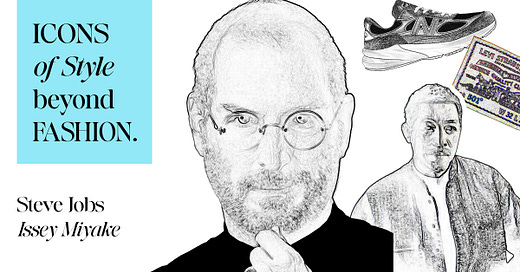In the world of technology, few figures have managed to leave as indelible a mark as Steve Jobs. Known for his visionary ideas and uncompromising commitment to simplicity, Jobs’ influence extended far beyond the devices he introduced to the world. His iconic wardrobe—a black turtleneck, Levi’s 501 jeans, and New Balance sneakers—transcended mere clothing to become a symbol of innovation, authenticity, and personal branding. As we launch our series "Icons of Style Beyond Fashion," we explore how this minimalist uniform not only defined Jobs but also reshaped perceptions of leadership in the modern era.
Personally, I find Jobs’ approach to style both fascinating and inspiring. While I deeply resonate with principles like "One wardrobe for all occasions," where a consistent, adaptable style embodies identity, and "Trust your feelings," where comfort and confidence come first, I know I couldn’t commit to wearing the same outfit day after day, year after year. For me, style isn’t just about alignment with who I am—it’s also about versatility. My wardrobe is a toolkit that lets me express my mood and adapt to my environment. Plus, I love fashion far too much to settle for one uniform for the next decade—even if it was designed by Issey Miyake ;-)
Now, let’s return to Steve Jobs because there are incredibly inspiring elements in how he discovered and embodied his style "beyond fashion."
The Birth of an Iconic Look
The story of Steve Jobs’s uniform begins in an unlikely place: Sony’s headquarters in Japan. During a visit in the 1980s, Jobs was struck by the uniforms worn by Sony employees, designed by the renowned Japanese fashion innovator Issey Miyake. These uniforms symbolized unity and identity within the company. Inspired, Jobs initially sought to replicate this concept at Apple, but his proposal was met with resistance from employees. Instead, he turned inward, asking Miyake to create a personal uniform—and thus, the iconic black turtleneck was born.
As Jobs recounted in his biography, Miyake made him “a hundred of them,” ensuring that this signature garment would last a lifetime. Jobs’s choice was more than practical; it was deeply intentional. It eliminated the need for daily wardrobe decisions, a nod to his belief in conserving mental energy for more important tasks—a concept now widely recognized as combating "decision fatigue."
A Wardrobe Rooted in Philosophy
Jobs’s uniform wasn’t just about simplicity; it was an outward manifestation of his core values. Each element—from the turtleneck to the sneakers—reflected principles that also guided Apple’s design ethos.
The Black Turtleneck
Designed by Miyake, this garment became a symbol of creativity and intellectual rigor. Its understated elegance mirrored Apple’s aesthetic: sleek, functional, and timeless. Jobs’s decision to adopt the turtleneck—a garment often associated with intellectualism and countercultural movements—positioned him as an innovator unbound by traditional corporate norms.
Levi’s 501 Jeans
Casual yet classic, Levi’s 501 jeans embodied a sense of accessibility. For Jobs, they weren’t just comfortable; they were also a nod to durability and craftsmanship. These jeans aligned perfectly with his vision of creating products that were not only beautiful but also built to last.
New Balance Sneakers
Jobs’s New Balance sneakers, particularly the 990 series, reflected his appreciation for quality and functionality. Manufactured in the U.S., they also hinted at his preference for authenticity and ethical production practices—values that resonate with Apple’s commitment to innovation and responsibility.
The Power of Consistency
By committing to this uniform, Jobs crafted a personal brand that was as consistent and recognizable as the Apple logo itself. This visual identity served multiple purposes. It differentiated him from traditional corporate executives clad in suits and ties, projecting a message of approachability and focus on innovation. It also reinforced his belief in minimalism, a principle that permeated every product Apple released under his leadership.
A Cultural Ripple Effect
Jobs’s sartorial choices didn’t just influence Apple employees or the tech industry. They set a precedent for other leaders, including Mark Zuckerberg and Barack Obama, who adopted simplified wardrobes to reduce decision fatigue and emphasize their focus on work over appearances. Today, the concept of a personal uniform has gained traction across industries, championed by creatives and executives alike.
Beyond the Clothes
Jobs’s style wasn’t about vanity or trends—it was an extension of his philosophy. His wardrobe choices reflected his dedication to simplicity, efficiency, and authenticity. They also underscored a deeper truth: leadership isn’t about blending in; it’s about standing out with intention and purpose.
Even now, more than a decade after his passing, Jobs’s black turtleneck remains a cultural artifact. It’s a reminder of how a seemingly mundane choice—what to wear—can resonate on a global scale when aligned with a greater vision.
Lessons for Leaders
Steve Jobs’s uniform teaches us that style is not just about aesthetics but about coherence and meaning.
For leaders looking to make an impact, the takeaway is clear: authenticity matters. Whether it’s through your words, actions, or even your wardrobe, consistency and intentionality can transform how you’re perceived and the legacy you leave behind.
As we continue exploring "Icons of Style Beyond Fashion," Steve Jobs sets the benchmark. His approach to personal branding—grounded in simplicity and innovation—offers timeless lessons for anyone seeking to lead with clarity and purpose. Because, as Jobs proved, true style is about much more than fashion; it’s about embodying who you are, every single day.
Join the Conversation
Who do you think has embodied a style that truly reflects who they are on the inside? Are there figures you believe should be featured in the "Icons of Style Beyond Fashion" series? Share your thoughts and suggestions—your ideas might just inspire the next feature!







